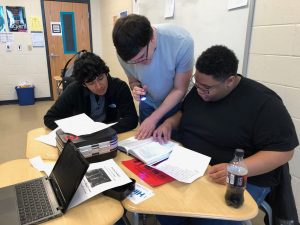Want to solve a murder mystery? Nab an art museum bandit? Escape zombies and prevent global destruction? Now you can!
Escape rooms are the newest trend in entertainment. Couples, families and friends around the world enjoy working together, discovering clues and solving puzzles to complete a mission. Critical thinking and collaboration is essential. Why not transfer those skills to the classroom through similar activities?
This year, with the help of our media specialist, my students participated in several breakout games. I created the first one for my AP Literature students to apply literary terms. Students entered the room to the sound of Coolio’s “Gangsta’s Paradise” blaring on the speakers, with the lyrics scrolling on the screen. They found two locked boxes on their table, along with a note which read: “Your lyrics are unique because they utilize many literary devices. You receive an urgent text message from one of your bandmates telling you that Rolling Stone is about to publish fake news about your latest song, which is sure to be a top-ten hit. Rolling Stone is going to give YOUR song songwriting credits to Taylor Swift! Evidence proving this news is bogus is stored in their editor’s lock box. You need to break open the box soon because the story goes to print in 45 minutes! You must rely on your knowledge of literature terms studied years ago to solve the clues and break into his box before time is up!”
Students were curious and excited to tackle this mystery.
The first clue comes from the allusion in the lyrics: “Though I walk through the valley of the shadow of death.” Upon hearing that line, most students recognized the words and used their electronics to find the source. For those who didn’t notice the allusion, I rewound the line again and again until it was painfully obvious! The line leads them to Psalm 23:4, which is the code for the first lock. Inside the box they found an black flashlight and a poem- another clue. By using the literary terms we studied in class, they were able to solve a variety of puzzles, open the final box and find their reward!
The students loved this activity and begged to do it again. Here are some of their comments from their subsequent reflections:
“Playing this game showed me just how unique each of us are with individual skills and certain parts of the game required skills that the other had. I learned that I am a really analytical thinker. I heard it a lot from my teachers but it’s another to see it really play out.”
“Me and my group worked together by sharing each other’s ideas and trying them. We gave each other turns to try different things. Playing this game taught me that I actually have some patience.”
“Solving a puzzle in the game relates to solving a problem in the real world because you have to go through steps to solve it, the things you solve could be real problems that need to be solved. Also because you could use the ways you solved the puzzle to solve your real world problems.”
“I found it very entertaining and mentally intensive.”
“I thought the Breakout activity was very beneficial in applying our knowledge of literature while also exercising our brain to conclude and be like detectives: thinking quickly… We didn’t want any hints because we knew we would feel better getting to the conclusion without cheating our way to it.”
Since the first try was a success, I also had my general ed English classes try breakouts over literary terms and Macbeth. The results were the same. This is an engaging activity to use with students at any level!
Our resourceful media specialist, Jessica Klinker, was fortunate to receive a grant from the South-Western City Schools Educational Foundation (SWCSEF) to purchase the equipment, but before that, we made do with regular wood boxes and locks the staff donated. Breakout EDU has many free scenarios available. Our next step will be having the students create their own breakout games. The critical thinking skills necessary to plan the clues take it to a higher level. I would strongly suggest trying it out with your students!


